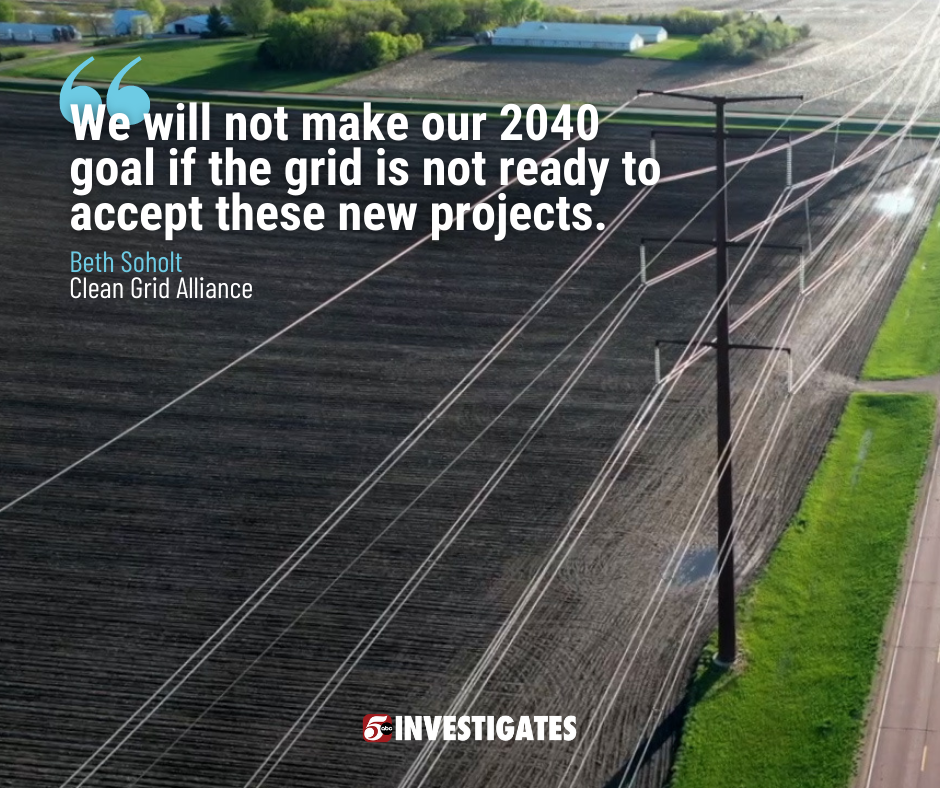Minnesota needs more transmission lines for renewable energy. Building them will take a decade or longer.
Minnesota’s power grid is not ready for the flood of renewable energy projects that are expected to come online as the state transitions toward 100% carbon-free electricity by 2040, according to industry experts and the state’s largest electric utility.
The new mandates will only be met by building more long-range transmission lines, shoring up the system that moves electricity from where it’s produced to where it’s consumed.
But renewable energy proponents warn the amount of time it takes to put those lines into service could drastically shorten the window the state has to meet its new energy standard.
“We will not make our 2040 goal if the grid is not ready to accept these new projects,” said Beth Soholt, executive director of Clean Grid Alliance.
The highway analogy
Energy experts say the best way to describe the power grid is to think of it like the freeway system.
The large transmission lines are like the four-lane interstate highways that crisscross Minnesota. Cars are the electricity.

Michael Lamb, senior vice president of transmission for Xcel Energy, said right now, there are too many cars and not enough lanes.
“There’s a huge traffic jam on the freeway system from southwest Minnesota to the Twin Cities,” he said during a recent interview with 5 INVESTIGATES.
The majority of the state’s renewable energy is produced along Minnesota’s Buffalo Ridge, a 60-mile stretch of land that starts in the south-central part of the state and extends northwest toward South Dakota.
Hundreds of wind turbines have popped up in that area over the last 20 years, leading residents in those rural communities to call the area Minnesota’s Wind Belt.
But Molly Malone, a Murray County commissioner, has warned that the lack of transmission is leading to a significant bottleneck of energy.
RELATED: How an ‘energy traffic jam’ is disrupting investment in Minnesota’s Wind Belt
“We can produce a lot of wind energy. Our problem is getting it out of the area,” said Malone.
The demand for more renewable energy projects will hit a roadblock if more transmission lines aren’t added to the highway, says Soholt, who’s worked in the energy sector for more than two decades.
“We don’t have any capacity for these new wind and solar farms,” she said.
The big infrastructure build-out
There are plans to add to this overburdened system.
In 2022, the Midcontinent Independent System Operator – or MISO – greenlit a massive grid expansion that includes more than a dozen long-range transmission lines in the Midwest.
As the grid operator, MISO directs the flow of electricity across 15 states, including Minnesota. Its reach extends from the U.S.-Canadian border to the Gulf of Mexico.
While MISO approves the plan, it’s up to the individual utility companies in those states to actually build the lines.
Lamb, with Xcel Energy, said this summer they expect to begin the permitting process on a line that will stretch from the South Dakota border to the far western edge of the Twin Cities.
A significant portion of that line that runs along Interstate 94 from Alexandria to Becker won’t require any additional infrastructure. Lamb said the towers were built in the 2000s with the capacity for a double circuit, where power lines run parallel on the same structure.
“We anticipated the need, two decades in advance, of adding a second circuit,” he said. “We’re just stringing a second circuit on structures that already exist.”
But the process isn’t as simple as stringing new lines.
Soholt says between the regulatory steps and construction, new transmission lines take, on average, seven to 10 years to complete.
“We’re going to need to execute very well,” she told 5 INVESTIGATES during a recent interview. “We don’t have a lot of time to waste. 2040 is not that far off.”